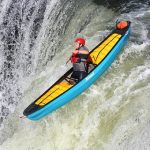It’s difficult to contain your enthusiasm for the incredible kayak that you have. Who else might consider it attractive and worth taking?
That’s right; potential thieves.
Kayaks are pricey, and that’s not lost on those who intend to do harm.
If you’re keeping it in the backyard or leaving it alone while out and about, it’s best to not leave your kayak vulnerable to theft. You need to keep your kayak safe.
Avoid taking risks; discover how to secure a kayak and make sure it is protected regularly!
How To secure Your Kayak
Depending on the type of kayak and what security is needed for it, there are a number of alternatives.
Anchor Point Locking Sit-On-Top Kayaks
Storing sit-on-top kayaks securely is best done by anchoring them close to an anchor point. These are a few ideas that could be implemented: a big tree, a kayak rack outdoors, or a pegs driven into the ground.
The problem is that your main support needs to be strong and stable. Unless someone who intends to steal a kayak realizes that your kayaks are the ones they want, they will not have the opportunity to lift them up.
Sit-on-top kayaks have scupper holes that make it easy to thread a lock through them once you reach your chosen mooring spot. Investing in a kayak lock for sit-on-top kayaks is reasonably priced because of this.
You can create your answer by purchasing some cord and a keyed or combination lock from your local hardware store.
You’ll typically have to develop your method if you want to lock up many kayaks at once. Most hardware shops will assist you in purchasing a straight piece of cable, then bending and securing the ends to form loops. You’ll need rope sleeves to feed the line through, loop it around, and then feed it back through before crimping the sleeve.
Be sure that if you tie a rope sleeve to your kayak, the loops should be small enough to fit through the openings on the underside of the sit-inside kayak. Prior to utilizing it, you should secure the rope sleeve and the bottom of the wire running through it with duct or Gorilla tape.
Occasionally, the tips of this cable may crack apart due to long-term usage of its stainless steel strands. If they become visible, they could become sharp and hazardous to your hands, so you should cover them with tape or another form of protection to stop yourself from getting hurt.
Once you have acquired your cable, you must wrap it around the fixing point, insert one loop into the other, and fasten it securely.
Once you pass the outer cord through the openings of your kayak, you will be able to secure it around the top and return it to the other end close to the anchor. You may also secure a direct line between two kayaks with a short cable, in the absence of enough length.
Anchor Point Locking Sit Inside Kayaks
Sit-inside kayaks do not have scupper holes, making it more challenging to secure them with a cable. This group employed a large, toppled tree trunk to be their primary stabilizing point.
The kayaks were tied to the tree by one loop in their cable around it, then the ends of the cable were secured to the bow and stern of both kayaks.
Loop one end of the cable around the front of the kayak and the other end around the back if you’re anchoring a single sit-inside kayak to a fixed point. A potential criminal will not be able to put one of the loops over and off the front or back of your kayak, since the cable is too tight to allow it.
If you are looking for a straightforward way to secure a kayak that you sit inside of to a fixed position, buying a pre-made lock designed for kayaks might be more beneficial than constructing one yourself.
A lock that is either one-keyed or has a combination, and two cables, are necessary for this technique. This is a basic illustration of the design of an individual kayak that can be sat in.
Sit-On-Top Kayaks Locked Together
You can connect multiple sit-on-top kayaks with a lock to prevent them from being taken away when you are not there. The basic idea behind this technique is that it is much harder for a single criminal to steal a large number of kayaks.
If they are firmly connected and difficult to separate, this is especially the case.
You can lock a sit-on-top kayak to an anchor point with the same technique that was described earlier. Run your rope inside the openings in the kayak, then tug it backward to fasten the circles on either end together.
If you have sufficient length, you can run the cable through two drains before attaching the ends back together. If there’s no close-by tie-up spot for you to attach your kayak to, this will likely be a more powerful hindrance against would-be kayak thieves.
Sitting Inside Kayaks Are Locked Together
If you aren’t close to an operative mooring point, it is also safe to chain together sit-in kayaks. Issues with sit-in kayaks are that they don’t possess holes which allow a rope to be strung through.
Metal rings that appear similar to this are affixed to the front and back of many single-occupant kayaks. They can be used to join two kayaks, but you’ll require a cable that is much thinner than would be essential to attach them to a solid object.
This means you will have to attach your fishing line to secure points on your sit-in kayaks.
You have to work out the size of the space below the curves so that you can ascertain if your lock can pass through the gap. If your kayak that is made to be sat inside of has a guard rail.
You may add specialized hooks that can be used to more securely attach multiple kayaks together. Here’s an illustration of how these eyelets appear:
This is a method to secure the kayak by threading a cable lock through the eyelets which fit into the kayak’s rails. This provides you with alternate ways to securely attach sit-in kayaks when the accessible tying points are too far apart to link them together.
How To Secure Your Kayak At Home & On The Go
Below are some scenarios where it is advisable to secure your kayak, as well as tips on how to do it properly.
How To secure A Kayak When On The Road
It is strongly suggested that you secure your kayak with a cable lock and tie-downs if you are taking it on the road using either a kayak trailer or a car’s roof rack.
No, scratch that.
Having a kayak lock to secure your kayak while travelling is essential.
Kayakers who are careful about safety should never try to move their kayaks unless they are safely attached to the vehicle.
The improper securing of your load on a roof rack while driving along the highway can have disastrous results; it can not only be destroyed beyond use but also put other drivers in danger.
Other than that, it’s wise to secure your kayak while travelling.
If you’re heading off to an isolated spot, it’s probable that you’ll need to pause your journey at different points. Leaving a kayak that is not secured on top of a car roof rack or trailer in a random parking lot or in an area not known by the owner is a surefire way to have it taken from them, even if they only leave it there temporarily or overnight.
The highest rate of kayak thievery occurs on the highway.
Using a Master Lock or similar item like a bicycle cable lock, you can make sure your kayak stays attached to your roof rack or trailer. Having a secure way to transport your kayak will give you confidence when it needs to be left alone for a short period of time.
Make sure to keep your kayak add-ons locked and away from view when transporting them in the vehicle. If the items are too large to fit inside the vehicle, secure them to the trailer or roof rack with lockable straps, such as those produced by LightSpeed.
If you own a sit-on-top kayak, you can take advantage of the scupper plug holes by lacing the cabled loop end through them before securing the kayak. You see, the those scupper plug holes aren’t just there for decoration!
Sit-inside kayaks do not usually have a pipe or scupper opening. A few of them come with specialized cords bars.
You can go for the option of using a Lasso locking cable, of if you prefer, you can drill and install a kayak lock hole for security, as long as you do not disrupt the water-tightness of the hull. This can be used to secure your kayak to the top of your car.
How To secure A Kayak When Stored At Home
The ideal way to preserve kayaks and keep them secure from potential thieves is to keep them inside a closed garage, shed, or house. You have a range of choices for keeping your kayak in a safe spot inside the house, such as a free-standing rack, a rack hung on the wall, or a suspension system.
The amount of space available is often why people select an inflatable as opposed to a hard-shell when they are choosing a canoe or kayak.
If your residence does not have room for your kayak, how can you make sure it is safe and secure when located outside?
Begin by ensuring that you place it near the residence. Instead of leaving your bike out in the open, you should think about mounting it to an outside wall of your home. Alternatively, if you have the skill set, you can craft a wooden rack to hold your bike.
If it’s not feasible to mount a kayak rack or you don’t have access to a garage, you can attach it to a tree or any secure element. Securely place a cable lock or several locks through and around the scupper plug holes or kayak handles, in order to make sure it is secured and protected.
Put the kayak in a cover designed for storing it and cover with a tarp to keep it hidden from potential robbers.
You should have the ability to put your belongings away from the ground and, most essentially, have an enduring attachment to which you can secure a locking wire.
Making it difficult to take something can be an effective way of avoiding thievery. You don’t need to purchase a costly locking system; one option is to secure your kayak to a permanent fixture with a chain and padlock or a cable lock mechanism, which will work adequately.
If you don’t feel like purchasing a wall mount kayak rack and need to store multiple kayaks, you can always come up with your own DIY freestanding rack. See the video above for more information.
How To secure A Kayak When Away From Home
Toting a kayak with you on outdoor journeys can be an enjoyable experience. Beginning the day to find out your kayak has been taken is a certain way to destroy an excellent weekend in nature.
If you left your vehicle in the vicinity of the campsite, a cable lock should be sufficient in order to secure your kayak to the vehicle’s tray or rack.
Yet if your destination is far and you have to go on foot, this approach won’t be practical.
If you’re going camping and don’t have your car with you, how can you store your kayak outside when you’re not using it?
For those of you who have inflatable or collapsible kayaks, you may be surprised at how conveniently transportable they are, so the easiest storage option would be to keep it inside your tent.
Securing hard-shells isn’t as straightforward, though. You’ll have to find permanent structures, such as a tree, nearby where you can fasten the kayak with a cable lock:
As long as there is a secure and permanent surface close to your camp area, such as a tree, log, or even a dock, you can be sure that you will be safe.
Securing kayaking supplies when away from home can be a bit more difficult. Try to keep your electronic kayak accessories in your tent if it is possible. If not, lock them up in the hull of your sit-on-top kayak. Paddles can be secured using a paddle-lock.
How To secure A Kayak: Summing It Up
It is irrelevant whether you are going to a recognizable place, a seemingly secluded campsite, or if you are staying in the hotel’s lot for the night.
If you are not watching your kayak, make sure to secure it with a lock.
The aim of understanding how to secure a kayak is to make it as hard and as dangerous as it can be for any would-be burglar.
It’s best to prevent theft of your kayak by making it hard enough that the potential thieves lose interest completely.
A kayak lock might not completely guarantee that your kayak won’t get stolen, but it does make it much less desirable to potential thieves!
Always make a note of your kayak’s Hull Identification Number, which can be used to help find your kayak if it is ever stolen.




